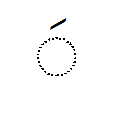Fatha
Fatḥa (فَتْحَة) is an optional character in the Arabic script that is used to vocalize text. It is used to identify the short vowel a (as in "Rand"). Like most of the other auxiliary signs, the Fatha, a short slash, is placed over the consonant to be vocalized (indicated as a circle in the graphic). A subsequent Alif or Alif maqsura can stretch the short sound a to ā ; the Arabic diphthongs au and ai are formed by Fatha followed by Waw or Ya .
A fatha is also used to denote the accusative ending -a (with determinate nouns and adjectives). If the accusative ending is indeterminate, the ending is -an , and two fathas ( fathatān , see also nunation ) are used. Fathatān needs an Alif , Alif maqsura , Ta marbuta or Hamza (alone or on an Alif) as a carrier.
In Persian the character is called Fathe or Zebar and, just like in Arabic, stands for a short a .
Fatha in Unicode
| Unicode codepoint | U + 064E |
|---|---|
| Unicode name | ARABIC FATHA |
| HTML | & # 1614; |
| ISO 8859-6 | unavailable |
Fathatān in Unicode
| Unicode codepoint | U + 064B |
|---|---|
| Unicode name | ARABIC FATHATAN |
| HTML | & # 1611; |
| ISO 8859-6 | unavailable |

